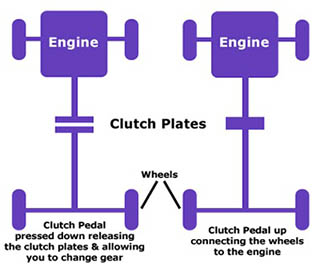How to Perform Clutch Control
To perform clutch control, press down the accelerator and clutch pedals together and find the ‘biting point.’
The clutch enables the engine to be disconnected from the transmission to engage or disengage the gears. It consists of two friction plates. When the clutch pedal is pressed down, the two friction plates move apart, which disconnects the engine from the wheels meaning none of the engine’s power can be transmitted to the wheels.
As you release the clutch, the two friction plates move together, and power starts to be transmitted to the wheels. This is known as the ‘biting point.’
The more the clutch pedal is released, the more the plates touch and the more power can be transmitted from the engine to the wheels. When the clutch pedal is fully released, the clutch plates lock together, meaning all the power from the engine can be sent to the wheels.
Clutch control is when you only half engage the clutch – so the clutch plates aren’t fully together. This can be helpful when needing to drive very slowly or when carrying out manoeuvres.

How To Find The Biting Point
- With the engine running, press the clutch pedal down using your left foot.
- Select 1st gear.
- Set the gas – press the accelerator pedal lightly with your right foot until you hear an even hum from the engine. The engine speed should only be about half as fast again as the tick-over speed. You should only need to press the accelerator down about the thickness of a one pound coin.
- Holding your right foot steady, raise the clutch pedal slowly by bending your ankle. Keeping your heel down will give you more support and positive clutch control. As you raise the clutch, listen for a slight drop in the engine speed. When you hear or feel this, you have found the holding point.
- Release the clutch a little more so that you see the bonnet begin to rise. This is the biting point. If you continue to release the clutch (slowly) the car will start to creep forward. If you want to stop this creep, gently press the clutch pedal down back beyond the biting point. This stop-start procedure is known as clutch control.
- Be aware – if you let the clutch pedal up too far or too quickly the engine is likely to stall.
Slipping The Clutch
This is holding the clutch pedal partially down so that the clutch is not fully engaged. This lets the engine rotate faster than it would if fully engaged. When manoeuvring at slow speeds it is often necessary to ‘slip the clutch’.
This technique is also useful when driving through shallow flood water, as it allows you to rev the engine higher at low speeds, forcing more exhaust fumes through the exhaust pipe which helps prevent water from travelling up the exhaust and into the car’s engine and causing expensive damage.
Slipping the clutch can cause excessive wear to the clutch, however, so use only when necessary.
Coasting
Driving with the clutch pedal pressed down is known as coasting. Obviously every time you change gear you will ‘coast’, but you should always try and keep coasting to a minimum, as it reduces the control you have over the car because:
- engine braking will be eliminated
- vehicle speed downhill will increase rapidly
- steering response will be affected especially on bends and corners
- it may be more difficult to select the appropriate gear when required.
Allowing the car to travel in neural gear is also coasting.
Riding The Clutch
Driving at a steady speed with your left foot resting on the clutch pedal is known as ‘riding the clutch.’ It may seem harmless, as the pedal doesn’t seem to be in use. However, clutches contain a clutch release bearing that applies pressure to the pressure plates to aid in releasing the clutch plates.
Resting your foot on the clutch can cause wear on the release bearing, and too much pressure can cause the plates themselves to slip, causing significant wear to the clutch plate friction material.
Press The Clutch Pedal All The Way Down?
You don’t have to press the clutch pedal fully down to change gear. In fact, if you do this, you will cause unnecessary stress and wear on the diaphragm spring in the release mechanism. To change gear, you only have to clear the drive to free the gearbox, which is achieved as soon as you have passed the ‘biting point.’
